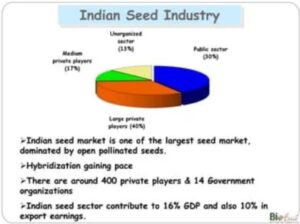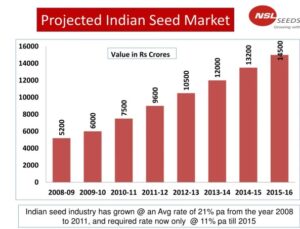Indian Seed Sector
Relevance
- GS Paper 3: Agriculture and related issues.
- Tags: #Seed Technology for Sustainable Growth, #challenges and opportunities of Seed Sector, #Emerging seed technology and applications
Why in the news?
- Recently, the two-day National Seminar on ‘Regulations and Governance issues in Indian Seed Sector ‘began in New Delhi today.
- Agriculture and allied sectors are central to the Indian economy. Keeping this and a sustainable future in mind, the Indian government, quite rightly, is promoting technology-enabled sustainable farming, including natural, regenerative, and organic systems, during its G20 presidency.
History of the Indian Seed Industry
- Strong Foundation (1960s):The National Seeds Corporation was established, setting the groundwork for the industry’s growth.
- Policy Impetus (Late 1980s):Proactive policies and regulatory support boosted the industry’s development.
- Legislative Landmark (2001):The Protection of Plant Varieties and Farmers Rights Act was enacted, bolstering intellectual property rights and innovation.
- Technological Transition (2002):The introduction of BT cotton hybrids marked a shift toward technology-driven approaches for better productivity and sustainability.
- Current Market Size: The Indian seed market is estimated at $4.0 to $6.0 billion, with untapped potential for global prominence.
- Millet Leadership: India’s global leadership in millet production positions it to capture the international seed market.
- Public-Private Collaboration: Collaboration between ICAR research institutions and private companies enhances the development of hybrid varieties.
Role of Seed Industry in India
To achieve the desired growth, the development, deployment, and dissemination of climate-resilient, efficient, resource-efficient, and high-yielding varieties (HYVs) are necessary, as the genetic gain obtained through plant breeding can only be translated into higher productivity.
- The rates of seed and variety replacement are still low, and as a result, the capital made in creating new varieties is ultimately wasted due to their subpar adoption and distribution.
- Large gaps are left because the majority of marginal and small farmers (M&SF) are unable to access high-quality seeds.
- The creation and expansion of traditional crop varieties with a focus on regional significance and unique adaptation should be prioritized.
- Because they are typically farmed with low inputs, high-volume, low-value crops have more seed issues that need to be solved.
The Indian seed industry is crucial to the development of the agricultural sector since it provides farmers with robust research, access to high-quality seeds and planting supplies, etc.
Challenges for the Indian Seed Industry
- Climate Variability: Unpredictable weather patterns and shifting climate conditions challenge consistent seed production, impacting crop yields and resilience.
- Resource Scarcity: Diminishing natural resources like water and arable land strains the industry’s capacity to meet the escalating demand for quality seeds.
- Regulatory Framework: Navigating evolving and intricate regulations can hinder the timely release of new seed varieties, obstructing innovation.
- Market Access: Equitable access to quality seeds, particularly in remote or economically disadvantaged regions, remains a significant challenge.
- Global Competition: The fiercely competitive international seed market demands continuous improvement in quality and variety offerings.
- Intellectual Property Protection: Safeguarding intellectual property rights while encouraging open innovation poses a delicate balancing act.
- Consumer Preferences: Adapting seed varieties to evolving consumer preferences concerning nutrition, taste, and environmental impact is a dynamic challenge.
Scope of Seed Technologies
- Priming and Enhancement Protocols: These protocols prepare seeds to excel under various growing conditions. Particularly valuable in regions experiencing stressors, they boost seed performance independently or in conjunction with the seed’s genetic attributes.
- Film Coating and Pelleting: Film coating involves a protective layer applied to seeds, aiding precise planting and acting as a vehicle for pesticides, nutrients, and growth promoters. Pelleting shares similar benefits, enhancing seed protection and handling.
- Seed Treatments: Seed treatments encompass the application of biological or chemical pesticides to seeds, with contact or systemic action against pests and diseases during germination and early growth stages.
- Bio-stimulants and Nutrients: Integration of bio-stimulants and nutrients into seeds fosters improved germination rates and rapid seedling establishment, contributing to overall plant vitality and productivity.
- AI-Responsive Sensors/Substances: Seeds infused with AI-responsive sensors or substances can adjust plant responses to external stimuli, bolstering adaptability and performance across varying conditions.
- Clean and Green Planting Materials: This technology revolves around generating environmentally friendly and high-performing planting materials for horticultural crops, aligning with sustainable cultivation practices.
- Genetic Advancements in Variety Development: Genetic enhancements play a pivotal role in creating seed varieties with amplified traits such as disease resistance, augmented yield, and enhanced adaptability to shifting environments.
- Metabolic Cues and Molecules: Seed enrichment with molecules or metabolites that act as cues in biological pathways can augment metabolic processes and overall plant well-being.
Conclusion
Despite achieving food security through the production of 330 MT of food grains, challenges persist in meeting the demand for coarse cereals, pulses, oil seeds, and vegetables. These shortcomings contribute to a large undernourished population, including a substantial child-wasting rate of 19.3%.
As India forges ahead with sustainable agriculture, embracing seed technologies emerges as a linchpin for progress. With robust regulatory mechanisms, India’s journey towards a Clean Green Mission can set the stage for a greener, more resilient agricultural future.
Way Forward: Embracing Seed Technology for Sustainable Growth:
- Research and Innovation: Invest in innovative research for climate-resilient, high-yielding seed varieties.
- Quality Assurance: Guarantee reliable access to quality-assured seeds to bolster the seed market’s stature.
- Tech Transfer: Facilitate technology dissemination to fields via farmer training and extension services.
- Empower Smallholders: Ensure affordable, quality seeds and provide capacity-building programs.
Source: The Indian Express
Mains Question
How can Indian agriculture benefit from improving seed technology? Explain.






